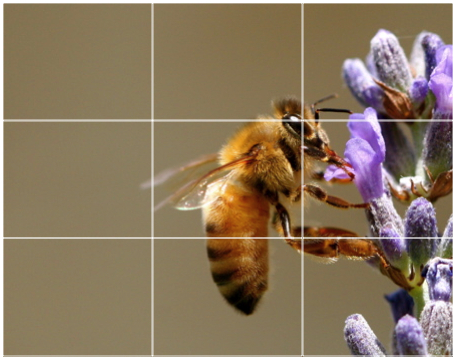In last week's post you analyzed a still image from Minority Report, identifying the type of shot, how the image advanced the plot and themes of the movie, and how small details within the shot all contribute to the meaning of the image.
This week we'll consider the composition of shots -- how we understand the subject of an image within the context of the camera frame. Framing photographs can give the subject a context; they can add layers of depth (foreground, background, or both); and perhaps most importantly they can lead the viewer's eye toward the main focal point.
Introduction to Framing:
The frame of a shot is where the subject is located in
the frame of the camera. In order to understand this, consider the frame—what
area of the picture you see—overlaid with a tic-tac-toe grid of 9 squares. The
middle frame is what photographers and directors call the lazy frame—it’s where
professionals usually don’t want their subjects to end up. Instead the subjects are
most often placed on one of the interstices—the places where two lines meet, usually left
or right, top or bottom of the lazy frame.
Notice the photos below:
The subjects—the middle of the chihuahua's head and also the bee’s head are to the right of the lazy
frame. While part of the body lands in the middle frame, it’s not the part of
the subject we are most interested in. This concept is called the rule of thirds.
Compare to this still from Minority Report (Spielberg, 2002):
Notice the hands on the tie are to the left and below the
middle "square," but on the lower horizontal line. The subject’s eyes are above the middle frame.
Another concept important to framing is foreground and background. Notice in the Minority Report still, the background provides a rich shot filled with detail that the viewer can see and helps to define character. It also balances the subject so that the subject is framed within the frame, between the woman tying his tie and the table and lamp.
Consider how individual shots in film are framed—and how a character is framed within it. The frame helps define the character, creates a sense of place, and guides us to what the director wants us to understand about the scene.
Your Turn: Photo Assignment
With a digital or phone camera take several different pictures placing your subject on the intersections around the middle frame. Experiment with capturing both foreground and background. Then frame your subject within the frame of the camera— i.e. find objects to create a frame within a frame. As you take your own shots consider how background and foreground inform your subject, and how their placement in the frame changes how we understand the situation.Take 5-10 pictures and post them to your blog with a short description for each that explains an effect of your framing.





